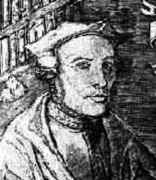Person: Frisius, Regnier Gemma

Regnier Gemma Frisius was a Dutch mathematician who applied his mathematical expertise to geography, astronomy and map making. He became the leading theoretical mathematician in the Low Countries.
Mathematical Profile (Excerpt):
- He was born Regnier Gemma and only adopted the name Frisius when he later became a scholar for, like many scholars from his country, he adopted a Latin version of his name.
- So Regnier Gemma became Gemma Frisius.
- Gemma attended school in Gröningen then, in 1526, he entered the University of Louvain.
- Gemma Frisius applied his mathematical expertise to geography, astronomy and map making.
- carefully corrected and with all errors set to right by Gemma Frisius ...
- Gemma's edition contained very few changes to the original text, but Gemma had made some alterations to some of the maps, particularly to 'America'.
- Gemma showed 'America' as two disconnected continents with the one south of the equator being named America while the one to the north of the equator was left without a name.
- It is reasonable to ask why Gemma Frisius would produce a new edition of Cosmographia within five years of the original with relatively few changes.
- The 1524 edition published by Apianus himself was not very popular and Gemma Frisius may have seen the potential to develop it into a more popular work.
- The next project undertaken by Gemma was to produce a combined terrestrial and celestial globe.
- Gemma published the book De Principiis Astronomiae Cosmographicae in the same year which was to supplement the globe.
- It was a work in three parts published in Antwerp by Johannes Grapheus (Gemma's original published Roeland Bollaert had died).
- It is worth noting that although there were many methods of finding longitude proposed in the 250 years following Gemma Frisius's work, ultimately the methods he proposed were to become the solution to finding the longitude at sea.
- In 1533 Gemma published an enlarged edition of Cosmographia which became a great commercial success.
- The Polish ambassador in Brussels became aware of the outstanding work being undertaken by Gemma Frisius and invited him to come to meet him at the Imperial court in Brussels.
- There he tried to persuade Gemma Frisius to go to Poland to collaborate with Copernicus.
- It was an interesting proposition which was very tempting but, after some indecision, Gemma decided to turn the offer down and he returned to Louvain.
- In 1534 Gemma Frisius published Tractatus de Annulo Astronomicae in which he described an instrument he called the astronomer's ring which he had designed and Van der Heyden had made in his workshop.
- From 1534 Gemma Frisius began to teach his student Gerardus Mercator and over the following years he cooperated with Gaspard Van der Heyden and Gerardus Mercator.
- After completing the terrestrial globe, Gemma's interests turned towards medicine.
- After a few weeks during which he was totally absorbed in medical matters, Gemma returned to working on his next globe.
- Gemma assisted the students, spending four days on the city walls keeping watch for the approach of the attacking forces.
- Gemma's work on astronomical instruments was described in several of his books.
- John Dee arrived in Louvain in 1548 and sought out Gemma Frisius and Gerardus Mercator.
- the first astronomer's staff in brass that was devised by Gemma Frisius; the two great globes of Gerardus Mercator; and the astronomer's ring of brass as Gemma Frisius had newly framed it.
- Gemma Frisius made many astronomical observations.
- Some of these comet observations are described in works by his son, Cornelius Gemma Frisius, who was born in 1533 and went on to become professor of medicine and astronomy at Louvain.
- Gemma Frisius died of 'stones' at the age of forty-seven.
Born 8 December 1508, Dokkum, Friesland, The Netherlands. Died 25 May 1555, Louvain, Brabant (now Belgium).
View full biography at MacTutor
Tags relevant for this person:
Astronomy, Geography, Origin Netherlands, Physics
Thank you to the contributors under CC BY-SA 4.0! 

- Github:
-

- non-Github:
- @J-J-O'Connor
- @E-F-Robertson
References
Adapted from other CC BY-SA 4.0 Sources:
- O’Connor, John J; Robertson, Edmund F: MacTutor History of Mathematics Archive
